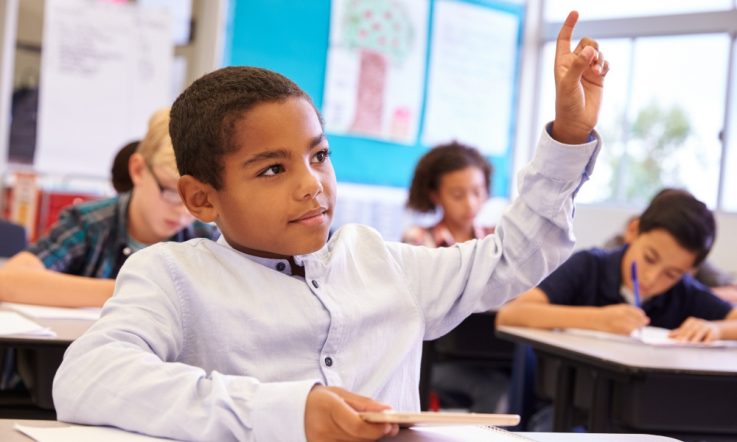This podcast from Teacher magazine is supported by Southern Cross University. Study a Master of Education online and complete your degree in 16 months part-time. Develop skills that will help drive change through contemporary, real-world strategies, and bring positive outcomes to student and teacher wellbeing. For more information visit: online.scu.edu.au/master-education
Hello and thank you for downloading this podcast from Teacher magazine – I'm Rebecca Vukovic.
My guest for the second episode in our Behaviour Management podcast series is Phil Beadle – a teacher, education consultant, public speaker, author and broadsheet columnist. Phil was once named Secondary Teacher of the Year in the UK and is considered an expert in the areas of literacy and behaviour management. In today's podcast he joins me on the line from the UK to discuss behaviour management, but in particular the different de-escalation techniques that educators can use to manage challenging behaviours in their classrooms.
Rebecca Vukovic: Phil Beadle, thanks for joining Teacher magazine. You've said that when it comes to de-escalation, ‘it's important to act quickly, be decisive, pick a technique and put it into action straight away'. So, what are some of the most effective de-escalation techniques you'd recommend to teachers?
Phil Beadle: Can I first say that perhaps that's a little bit glib? I'm aware, I think it's Why are you shouting at us that that's in. But that is a bit of a glib thing in that the choice of when you put a de-escalation technique in is probably one of the most complex things of all, in that you have so many different things to consider and you have to consider them so quickly.
In a crisis stage, then you have to rapidly do a very quick risk assessment and it might be that the appropriate de-escalation technique is just to stand there and observe. Alternatively, it might to be come in really quite quickly.
For me, at an early stage of a behaviour incident, then redirection is generally the best technique, where you just redirect the child away from their emotional landscape, you redirect the child away from the triggers and just put them onto something else. Now, that can be quite as simple as ‘let's just focus on the work and forget about it' kind of tactically ignoring. Or it can take a pleasingly surreal bent, where you just deliberately employ some kind of surreal humour when they've been triggered. So, for instance, if somebody has said something unpleasant about someone's mum, you might reply, ‘yeah but what about the fact that my mum still buys my clothes and I'm over 50?' And in doing so, you've just redirected them away from their emotional landscape.
Another thing I think is really a fantastically useful technique for teachers is just stating your recognition of a child's emotional state. So simply the phrase, ‘I can see that you're getting upset', helps them to recognise that they're getting upset themselves to put their own controls in place.
RV: One thing that I found really interesting is that you've said that humour can be one of the best de-escalation techniques. Why have you found that humour works best?
PB: There's some absolutely fascinating science about this actually in that scientists' best guesses is as to how laughter evolved, is that it's the relaxation of the grimace of extreme mortal fear. So, you can imagine you're on the African savannah in the Palaeolithic times running away from a sabre-toothed tiger, your face would go into this kind of rictus grimace, and then the sabre-toothed tiger breaks their leg as they're running after you. It's that kind of relaxation of absolute up-tightness is how laughter is meant to have evolved.
Now, if you're making a student laugh at the beginning of the process when they're triggered into reactive anger, then what you're actually doing is you've short-circuited them towards the end. So laughter as a redirection technique, which of course is not recommended for kids with autistic spectrum disorders, and laughter as a redirection technique takes them to the end of the process but it also takes them outside of the self. There's a wonderful phrase about laughter, that ‘it's the shortest distance between two people' – so it's a brilliant way of achieving rapport and then being able to redirect kids away from their emotional state and then back onto the work.
RV: Now on a more practical level, when a teacher is being presented with behaviour that's immensely challenging, what techniques could they use to de-escalate this behaviour? Could you take me through some of the steps they should take?
PB: The first thing is just two words: go cold. Much of student behaviour – certainly whilst not reactive anger, the proactive anger – is about desiring a behaviour from the teacher, it's about controlling the teacher's behaviour. And what children in the state of manipulative aggression want is they want an emotional response. They want you to behave emotionally, because if you behave emotionally then you're not going to be entirely in charge.
So the first thing we do in really troubling situations is we go cold and then we go by the book. For instance, I had a situation this year where an erstwhile, quite delightful young man named Charlie threw a book in my face in front of the rest of the class and I did find myself in the absurd situation of ‘what do I write that you should do here?'. And we go unemotional immediately, and then we go back to the book. So, Charlie chucked the book in my face and wandered out and I found myself feeling somewhat impotent as I said ‘That was entirely inappropriate behaviour…' as he slammed the door off its hinges, ‘…and there will be a sanction Charles!' And whilst it does feel slightly impotent, actually it's a trained professional response. So, if you're dealing with immensely challenging behaviour, be certain that you do not give an emotional response but you give a professional one.
RV: So what about the more minor infringements, what can a teacher do to ensure these minor disruptions don't escalate into more serious issues?
PB: Well it's about being with it from the off, really. If I'm sitting at the back of other teachers' lessons, judging their validity and ticking things on a clipboard, the first thing that I'll note is that the minor behavioural infractions are not challenged. Such as, if gum is not spat into the bin straight away or if there's not an insistence on the minor rules, if there are bags on the table, if the jackets are not on the chairs – then actually that's a classroom in which the bigger behavioural incidents are going to take place. So with minor stuff, it's all about nipping it in the bud absolutely immediately, and again there's quite a nice phrase: ‘just sweat the small stuff and then the big stuff doesn't happen'.
RV: You've said before, and I like this quote, ‘what's best for the child? – that's a mantra that teachers have got to have in their souls'. And I guess with this in mind, how do teachers de-escalate the tension from poorly behaving students, while ensuring that the well-behaved students aren't negatively affected at the same time?
PB: Managing behaviour adequately, or well, is an entirely egalitarian approach. So what do the high achieving and more compliant students want? They want a calm and purposeful environment in which they can learn. So we have to differentiate our behaviour to focus on those students for whom behaviour is more of a challenge, in order to keep the classroom purposeful and people learning.
So, you won't have a situation where a ‘more compliant' student will be upset that a teacher is actively managing the behaviour of the kids for whom behaviour is more of a challenge.
The ‘what's best for the child?' mantra is in specific reference to the most challenging of all situations. So, we're hitting a really heavy weight crisis stage and the child's behaviour is distinctly unlovable. It's in these kind of crisis-related incidents that we have this mantra, ‘what's best for the child?' And there's also the really delightful phrase, ‘who needs the most love in the room is the person who is behaving in the most unlovable manner'.
RV: That is a great quote! Because often it is about timing and a teacher knowing when they should intervene. So are there any kind of rules of when a teacher should intervene when a student is behaving badly?
PB: I think to a certain extent we've covered this in the first question in that the point at which you intervene is probably the most technically complex of all because you've got so many distinct things. And there is an element to that, that it can't really be trained. It's to do with the teacher's professional discretion and crucially to do with their relationship with the students – in that if you have an active and productive relationship with the student then that's going to affect the way in which you intervene and the timing in which you intervene. Whereas, if you have no relationship whatsoever with the student, then it's going to affect your behaviour. And also probably, if you have no relationship whatsoever with the student, you'll want to observe for a little bit more to see what's happening.
RV: I've been thinking a little bit about personal triggers, so how do teachers actually identify their own personal triggers and responses to poor behaviour?
PB: This is kind of a lifelong journey in that I've only been teaching for just over 20 years and I'm only just getting to an understanding of what my own personal triggers are. I think for me again, the key mantra here is an understanding – and I think this is probably the most profound thing I've learned in life, let alone in teaching – that the only thing you can change is yourself. Anybody that attempts to change other people is a fool.
So, in situations where you have potentially a very challenging class and they're setting challenges on a day-to-day basis, you cannot actively change their behaviour.
What you can do is change the way you react to that behaviour. And it's your ability to model the process of change which cuts through to the class.
And it's making these tiny on a day-by-day distinction where… For instance, I do a thing which I was taught by this brilliant guy John Murphy with whom I wrote the book (Why are you shouting at us?) called the behaviour impact analysis. Now John was previously the head of a residential emotional behavioural difficulties unit for seven years, and his early stages he said he was doing what's called a behaviour impact analysis on himself for every single class of every single day. And it's all about how in the most challenging circumstances, just making these minute changes to behaviour and asking “what is the effect of your own behaviour as a teacher on the students?” – if that effect is negative, then the behaviour of the teacher has got to change.
RV: And Phil, what about follow-up? So, once a situation has been de-escalated, how do you follow-up the next day? Because is it something that needs to be acknowledged or is it better to just let it go?
PB: What we're talking about is managing the comedown. With reactive anger, it follows a repetitive cycle where it takes 45 minutes for the adrenaline that's caused the outburst to subside and the child will remain in a hair-trigger state for those 45 minutes. So, within that 45 minutes post a behavioural incident then a child has to be looked after, and the child has to be reassured, because what's one's automatic human reaction to having behaved very poorly? It's shame. And what we don't want is a child [to be left to stew in their own shame].
So what we need to do, post a behavioural incident, is manage that, and just let the child know that everything is going to be okay. In terms of the procedural stuff post that, well that's a responsibility of individual schools' behavioural policies. So, depending on the incident you might be required to write it up. But my expertise is not within the procedural or within the policy, my expertise is what happens within the classroom. So once you've managed a comedown situation … a word of advice if you've got two boys fighting, don't immediately get them to shake hands afterwards because it's just going to flare up again. But in terms of the procedural aspect of it, that's the individual school's policy that need to be followed.
RV: Are de-escalation techniques down to the individual teacher or are they something that can be managed by a school-wide plan?
PB: Clearly it's to do with the individual teacher because it's the individual teacher that will manage it. However the issue, the school-wide issue, is do the teachers have the skillset and do they have the training? In that all of us, I think – when we enter a classroom for the first time post our training – feel somewhat underequipped to deal with some of the unruly behaviour with which we might be presented. My belief is that … For instance the book, the Why are you shouting at us? book, was written with an expert from behavioural units and my belief is that the expertise that the people within those environments have has not actually crossed over into the mainstream.
So my argument would be that each school, every teacher needs training in these techniques so that they can apply them individually. Clearly the training that they receive is a matter of school policy, but in terms of one's application of de-escalation techniques, you can't use them unless the school has a policy to equip you with the training that you need in order to actually own them.
RV: Just finally Phil, I guess this is on a more personal level, when you think back on your own career, have you changed your approach to de-escalation over the years?
PB: Oh gosh yeah! I had no training whatsoever and I was thinking about this this morning, I was gifted … I started my career in perhaps arguably the very toughest school in the East End [of London]. There were rumours that it was going to close, there were 20 NQTs (newly qualified teachers) on the first day and I was gifted two of the more challenging classes in that school as their drama teacher. I recall 8D, who I could not control at all, shouting at them so loudly that I almost collapsed because it brought stars to my eyes.
Massively, my approach to behaviour has changed massively in that I've become interested in it because I was so, so useless at the beginning. One becomes interested in it, one does research, one leads the people doing good work. And so, ultimately, my progress has been one from chaos to calm to an extent.
I'm no longer … on a teaching and learning basis, I tend to pride myself on being quite a fissile element, but actually in terms of the management of behaviour, I'm no longer a fissile element in the room that adds to the noise and adds to the chaos. I'm this utterly calm and surprisingly professional practitioner.
That's all from this podcast from Teacher magazine. To check out the full podcast transcript and related reading, visit www.teachermagazine.com.au. To download all of our podcasts for free head to acer.ac/teacheritunes or www.soundcloud.com/teacher-acer
You've been listening to a podcast from Teacher magazine supported by Southern Cross University. Study a Master of Education online and complete your degree in 16 months part-time. Develop skills that will help drive change through contemporary, real-world strategies, and bring positive outcomes to student and teacher wellbeing. For more information visit: online.scu.edu.au/master-education
Phil Beadle says that identifying your own triggers is a lifelong journey. As an educator, how do you identify your personal triggers and responses to poor behaviour?
Consider the steps you take to de-escalate poor behaviour in your classroom. Can you draw on any of the techniques suggested by Phil Beadle in today’s podcast to improve your practice?



